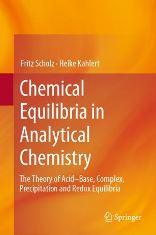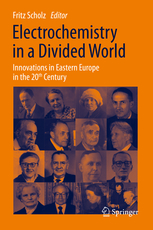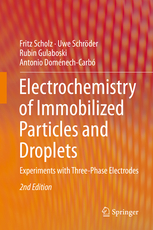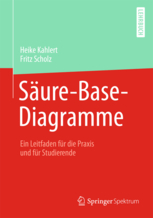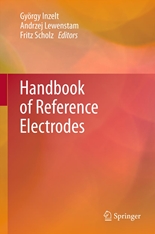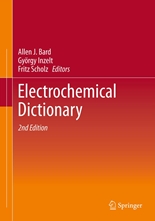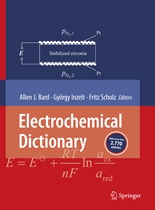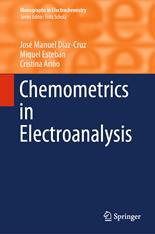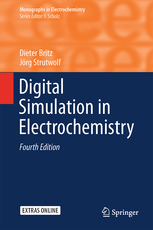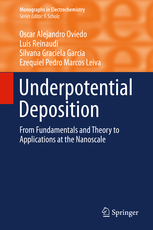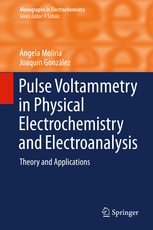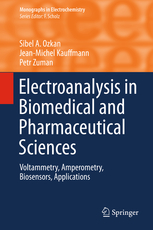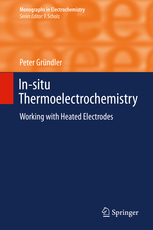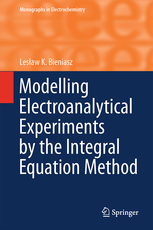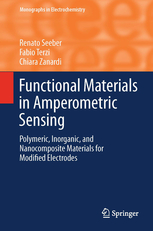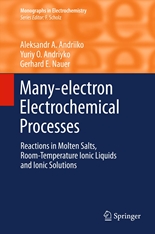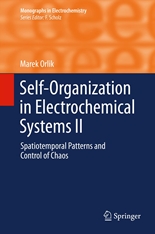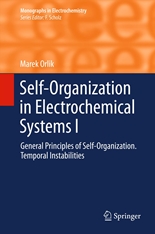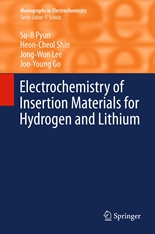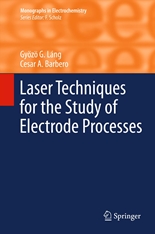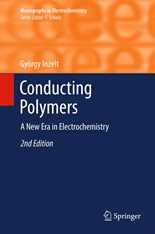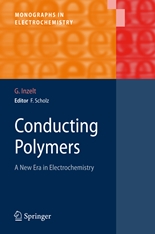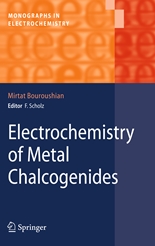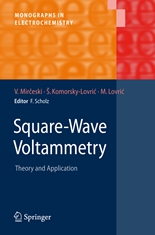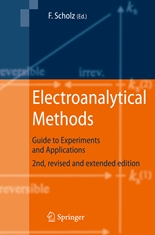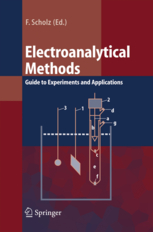Chemical Equilibria in Analytical Chemistry
F. Scholz, H. Kahlert, Springer Nature, 2019, ISBN: 978-3-030-17179-7 (Print), ISBN: 978-3-030-17180-3 (ebook), 251 p.
This book provides a modern and easy-to-understand introduction to the chemical equilibria in solutions. It focuses on aqueous solutions, but also addresses non-aqueous solutions, covering acid–base, complex, precipitation and redox equilibria. The theory behind these and the resulting knowledge for experimental work build the foundations of analytical chemistry. They are also of essential importance for all solution reactions in environmental chemistry, biochemistry and geochemistry as well as pharmaceutics and medicine.
Each chapter and section highlights the main aspects, providing examples in separate boxes. Questions and answers are included to facilitate understanding, while the numerous literature references allow students to easily expand their studies.
Chemische Gleichgewichte in der Analytischen Chemie
F. Scholz, H. Kahlert, Springer Spektrum, 2018, ISBN: 978-3-662-57452-2 (Print), ISBN: 978-3-662-57453-9 (ebook), 260 p.
Dieses Lehrbuch gibt eine moderne und verständliche Darstellung der chemischen Gleichgewichte in Lösungen. Wegen ihrer Bedeutung werden hauptsächlich wässrige Lösungen behandelt, ohne aber nichtwässrige Systeme zu vernachlässigen. Die Theorie und die daraus abgeleiteten Erkenntnisse für experimentelle Arbeiten bilden einerseits die Grundlage der Analytischen Chemie und sind andererseits für alle Lösungsreaktionen in der Umweltchemie, Biochemie, Geochemie bis hin zur Pharmazie und Medizin von essenzieller Bedeutung. Seit mehreren Jahrzehnten ist dieses Lehrbuch das erste, in welchem die chemischen Gleichgewichte in Lösungen wieder als eigenständiges Lehrgebiet, dem eine grundlegende Bedeutung für die gesamte Chemie zukommt, vorgestellt werden.Das Buch ist für Studierende der Chemie, Biochemie, Pharmazie, Umweltwissenschaften und aller anderen Studiengänge mit Chemie-Modulen geeignet.
Wilhelm Ostwald - The Autobiography
R. S. Jack, F. Scholz (Eds.), Springer, 2017, ISBN: 978-3-319-46953-9 (Print), ISBN: 978-3-319-46955-3 (ebook), 688 p.

This book is the translated and commented autobiography of Wilhelm Ostwald (1853-1932), who won the Nobel Prize for Chemistry in 1909. It is the first translation of the German original version “Lebenslinien: Eine Selbstbiographie,” published by Ostwald in 1926/27, and has been painstakingly translated. The book includes comments and explanations, helping readers to understand Ostwald’s text in the historical context of Germany at the beginning of the 20th century.In his autobiography, Ostwald describes his impressive research career and his life from his own personal view. Readers will find information on how Ostwald immortalized himself through his research on catalysis, chemical equilibria, technical chemistry, and especially as one of the founders of modern physical chemistry. His broad interests in science, ranging from philosophy to the theory of colors and the idea of a universal scientific language are further remarkable aspects covered.This work will appeal to a broad audience of contemporary scientists: Wilhelm Ostwald has been tremendously influential for the development of chemistry and science, and many of today’s best-known international scientific schools can be traced back to Ostwald’s students. Ostwald was active in Germany and what is now Latvia and Estonia, while also travelling to the USA, England and France. In his discussions and analyses of the working conditions of the time, readers will find many issues reflected that continue to be of relevance today.
Electrochemistry in a Divided World
Scholz, Fritz (Ed.), Springer, 2015, ISBN: 978-3-319-21220-3 (Print), ISBN: 978-3-319-21221-0 (ebook), 471 p.
In this collection of interrelated essays, the authors review landmark developments in electrochemistry building on biographic material and personal insight. The book facilitates understanding of the innate pathways of developments in electrochemical science as a result of lucky circumstances fitting to objective conditions. Thus the book will help to understand the present state of electrochemistry and offer inspiration for solving today’s scientific challenges. The authors as experienced electrochemists from the U.S., Western and Eastern Europe also provide guidance for scientific careers by presenting biographical examples of famous electrochemists.
Electrochemistry of Immobilized Particles and Droplets, 2nd edition
F. Scholz, U. Schröder, R. Gulaboski, A. Doménech-Carbó, Springer, 2015, ISBN: 978-3-319-10842-1 (Print), ISBN 978-3-319-10843-8 (ebook), 329 p.
This second edition of a successful and highly-accessed monograph has been extended by more than 100 pages. It includes an enlarged coverage of applications for materials characterization and analysis. Also a more detailed description of strategies for determining free energies of ion transfer between miscible liquids is provided. This is now possible with a “third-phase strategy” which the authors explain from theoretical and practical points of view. The book is still the only one detailing strategies for solid state electroanalysis. It also features the specific potential of the techniques to use immobilized particles (for studies of solid materials) and of immobilized droplets of immiscible liquids for the purpose of studying the three-phase electrochemistry of these liquids. This also includes studies of ion transfer between aqueous and immiscible non-aqueous liquids. The bibliography of all published papers in this field of research has been expanded from 318 to now 444 references in this second edition. Not only are pertinent references provided at the end of each chapter, but the complete list of the cited literature is also offered as a separate chapter for easy reference.
Electrochemistry of Immobilized Particles and Droplets
F. Scholz, U. Schröder, R. Gulaboski, Springer, 2005, ISBN: 3-540-22005-4, 290 p.
Immobilizing particles or droplets on electrodes is a novel and most powerful technique for studying the electrochemical reactions of three-phase systems. It gives access to a wealth of information, ranging from quantitative and phase analysis to thermodynamic and kinetic data of electrode processes. Three-phase electrodes with immobilized droplets provide information on the electrochemistry of redox liquids and of compounds dissolved in inert organic liquids. Such measurements allow the determination of the Gibbs energies of the transfer of cations and anions between immiscible solvents, and thus make it possible to assess the hydrophobicity of ions – a property that is of great importance for pharmaceutical applications, biological studies, and for many fields of chemistry.
The monograph gives, for the first time, a comprehensive overview of the results published in more than 300 papers over the last 15 years. The experiments are explained in detail, applications from many different fields are presented, and the theoretical basis of the systems is outlined.
Acid-Base Diagrams
H. Kahlert, F. Scholz, Springer, 2013, ISBN: 978-3-642-37901-7 (Print), ISBN: 978-3-642-37902-4 (ebook), 136 p.
-The first textbook focusing on fundamentals and application of acid-base diagrams
-In-depth yet simple presentation
-Full-color diagrams throughout
-Learning features such as boxed results and a collection of formulae
Understanding acid-base equilibria made easy for students in chemistry, biochemistry, biology, environmental and earth sciences. Solving chemical problems, be it in education or in real life, often requires the understanding of the acid-base equilibria behind them. Based on many years of teaching experience, Heike Kahlert and Fritz Scholz present a powerful tool to meet such challenges. They provide a simple guide to the fundamentals and applications of acid-base diagrams, avoiding complex mathematics. This textbook is richly illustrated and has full color throughout. It offers learning features such as boxed results and a collection of formulae.
Säure-Base-Diagramme
H. Kahlert, F. Scholz, Springer, 2014, ISBN: 978-3-642-37703-7 (Print), ISBN: 978-3-642-37704-4 (ebook), 98 p.
Das Buch gibt eine Anleitung zur Beschreibung von Säure-Base-Gleichgewichten mithilfe von einfach zu konstruierenden Diagrammen, die es erlauben,
- pH-Werte von Lösungen grafisch zu ermitteln,
- Gleichungen für die Berechnung von pH-Werten abzuleiten (die möglichen Näherungen zu erkennen),
- den Verlauf von Titrationskurven einfach auf grafischem Weg zu ermitteln,
- die in Säure-Base-Systemen bei bestimmten pH-Werten dominierenden Spezies zu erkennen, usw.
Das Buch ist insbesondere für Studierende der Chemie, Biochemie, Pharmazie, Umweltwissenschaften und anderer Studiengänge mit Chemie-Modulen geeignet.
Handbook of Reference Electrodes
G. Inzelt, A. Lewenstam, F. Scholz (Eds.), Springer, 2013, ISBN: 978-3-642-36187-6 (Print), ISBN: 978-3-642-36188-3 (ebook), 344 p.
-The only handbook on this topic
-Provides reliable data for the proper choice and construction of reference electrodes for all kinds of electrochemical systems
-Clear and illustrated presentation of the required basic know-how
Reference Electrodes are a crucial part of any electrochemical system, yet an up-to-date and comprehensive handbook is long overdue. Here, an experienced team of electrochemists provides an in-depth source of information and data for the proper choice and construction of reference electrodes. This includes all kinds of applications such as aqueous and non-aqueous solutions, ionic liquids, glass melts, solid electrolyte systems, and membrane electrodes. Advanced technologies such as miniaturized, conducting-polymer-based, screen-printed or disposable reference electrodes are also covered. Essential know-how is clearly presented and illustrated with almost 200 figures.
Electrochemical Dictionary, 2nd Edition
A. J. Bard, G. Inzelt, F. Scholz (Eds.), 2nd ed., Springer, 2012, ISBN: 978-3-642-29550-8 (Print), ISBN: 978-3-642-29551-5 (ebook), 991 p.
-More than 300 new or revised terms
-Almost 3000 entries in total
-Essential knowledge for Electrochemistry and Energy Research
-Among most-downloaded chemistry content on Springer.Link
This second edition of the highly successful dictionary offers more than 300 new or revised terms. A distinguished panel of electrochemists provides up-to-date, broad and authoritative coverage of 3000 terms most used in electrochemistry and energy research as well as related fields, including relevant areas of physics and engineering.
Each entry supplies a clear and precise explanation of the term and provides references to the most useful reviews, books and original papers to enable readers to pursue a deeper understanding if so desired. Almost 600 figures and illustrations elaborate the textual definitions. The “Electrochemical Dictionary” also contains biographical entries of people who have substantially contributed to electrochemistry.
Electrochemical Dictionary
A. J. Bard, G. Inzelt, F. Scholz (Eds.), Springer, 2008, ISBN: 978-3-540-74597-6 (Print), ISBN 978-3-540-74598-3 (ebook), 723 p.
-Fast access to the terms without the need to consult multi-volume encyclopedias
-Up-to-date, broad and authoritative coverage of the specific terms most used in electrochemistry and adjacent sciences and technologies
-Supplies clear and precise explanations of the terms, cross-references to related entries and up-to-date references to important publications
-Written by a distinguished panel of eminent electrochemists
Chemometrics in Electroanalysis
J. M. Díaz, M. Esteban, C. Ariño, 2019, ISBN: 978-3-030-21383-8 (Print), ISBN: 978-3-030-21384-8 (ebook), x, 202 p.
This monograph covers the most relevant applications of chemometrics in electrochemistry with special emphasis on electroanalytical chemistry. It reviews the use of chemometric methods for exploratory data analysis, experimental design and optimization, calibration, model identification, and experts systems. The book also provides a brief introduction to the fundamentals of the main chemometric methods and offers examples of data treatment for calibration and model identification. Due to the comprehensive coverage, this book offers an invaluable resource for graduate and postgraduate students, as well as for researchers in academic and industrial laboratories working in the area of electroanalysis and electrochemical sensors.
Digital Simulation in Electrochemistry
D. Britz, J. Strutwolf, ISBN: 978-3-319-30290-4 (Print), ISBN: 978-3-319-30292-8 (ebook), xv, 492 p.
This book explains how the partial differential equations (pdes) in electroanalytical chemistry can be solved numerically. It guides the reader through the topic in a very didactic way, by first introducing and discussing the basic equations along with some model systems as test cases systematically. Then it outlines basic numerical approximations for derivatives and techniques for the numerical solution of ordinary differential equations. Finally, more complicated methods for approaching the pdes are derived.
The authors describe major implicit methods in detail and show how to handle homogeneous chemical reactions, even including coupled and nonlinear cases. On this basis, more advanced techniques are briefly sketched and some of the commercially available programs are discussed. In this way the reader is systematically guided and can learn the tools for approaching his own electrochemical simulation problems.
This new fourth edition has been carefully revised, updated and extended compared to the previous edition (Lecture Notes in Physics Vol. 666). It contains new material describing migration effects, as well as arrays of ultramicroelectrodes. It is thus the most comprehensive and didactic introduction to the topic of electrochemical simulation.
Underpotential Deposition. From Fundamentals and Theory to Applications at the Nanoscle
O. A. Oviedo, L. Reinaudi, S. G. García, E. P. M. Leiva, 2016, ISBN: 978-3-319-24392-4 (Print), ISBN: 978-3-319-24394-8361 (ebook), p.
With this volume, Ezequiel P. M. Leiva and co-authors fill a gap in the available literature, by providing a much-needed, comprehensive review of the relevant literature for electrochemists, materials scientists and energy researchers. For the first time, they present applications of underpotential deposition (UPD) on the nanoscale, such as nanoparticles and nanocavities, as well as for electrocatalysis. They also discuss real surface determinations and layer-by-layer growth of ultrathin films, as well as the very latest modeling approaches to UPD based on nanothermodynamics, statistical mechanics, molecular dynamics and Monte-Carlo simulations.
Pulse Voltammetry in Physical Electrochemistry and Electroanalysis
Á. Molina, J. González, 2016, ISBN: 978-3-319-21250-0, ISBN: 978-3-319-21251-7 (ebook), 671 p.
For the first time, the authors provide a comprehensive and consistent presentation of all techniques available in this field. They rigorously analyze the behavior of different electrochemical single and multipotential step techniques for electrodes of different geometries and sizes under transient and stationary conditions. The effects of these electrode features in studies of various electrochemical systems (solution systems, electroactive monolayers, and liquid-liquid interfaces) are discussed. Explicit analytical expressions for the current-potential responses are given for all available cases. Applications of each technique are outlined for the elucidation of reaction mechanisms. Coverage is comprehensive: normal pulse voltammetry, double differential pulse voltammetry, reverse pulse voltammetry and other triple and multipulse techniques, such as staircase voltammetry, differential staircase voltammetry, differential staircase voltcoulommetry, cyclic voltammetry, square wave voltammetry and square wave voltcoulommetry.
Electroanalysis in Biomedical and Pharmaceutical Sciences
S. A. Ozkan, J.-M. Kauffmann, P. Zuman, 2015, ISBN: 978-3-662-47137-1 (Print), ISBN: 978-3-662-47138-8 (ebook), 350 p.
Through this monograph, the pharmaceutical chemist gets familiar with the possibilities electroanalytical methods offer for validated analyses of drug compounds and pharmaceuticals. The presentation focuses on the techniques most frequently used in practical applications, particularly voltammetry and polarography. The authors present the information in such a way that the reader can judge whether the application of such techniques offers advantages for solving a particular analytical problem. Basics of individual electroanalytical techniques are outlined using as simple language as possible, with a minimum of mathematical apparatus. For each electroanalytical technique, the physical and chemical processes as well as the instrumentation are described. The authors also cover procedures for the identification of electroactive groups and the chemical and electrochemical processes involved.
Understanding the principles of such processes is essential for finding optimum analytical conditions in the most reliable way. Added to this is the validation of such analytical procedures. A particularly valuable feature of this book are extensive tables listing numerous validated examples of practical applications. Various Indices according to the drug type, the electroactive group and the type of method as well as a subject and author index are also provided for easy reference.
In-situ Thermoelectrochemistry
P. Gründler, 2015, ISBN: 978-3-662-45817-4 (Print), ISBN: 978-3-662-45818-1 (ebook), 144 p.
This book represents the first rigorous treatment of thermoelectrochemistry, providing an overview that will stimulate electrochemists to develop and apply modern thermoelectrochemical methods. While classical static approaches are also covered, the emphasis lies on methods that make it possible to independently vary temperature such as in-situ heating of electrodes by means of electric current, microwaves or lasers. For the first time, “hot-wire electrochemistry” is examined in detail. The theoretical background presented addresses all aspects of temperature impacts in the context of electrochemistry.
Modelling Electroanalytical Experiments by the Integral Equation Method
L. K. Bieniasz, 2014, ISBN: 978-3-662-44881-6 (Print), ISBN: 978-3-662-44882-3 (ebook), 406 p.
This comprehensive presentation of the integral equation method as applied to electro-analytical experiments is suitable for electrochemists, mathematicians and industrial chemists. The discussion focuses on how integral equations can be derived for various kinds of electroanalytical models. The book begins with models independent of spatial coordinates, goes on to address models in one dimensional space geometry and ends with models dependent on two spatial coordinates. Bieniasz considers both semi-infinite and finite spatial domains as well as ways to deal with diffusion, convection, homogeneous reactions, adsorbed reactants and ohmic drops. Bieniasz also discusses mathematical characteristics of the integral equations in the wider context of integral equations known in mathematics. Part of the book is devoted to the solution methodology for the integral equations. As analytical solutions are rarely possible, attention is paid mostly to numerical methods and relevant software. This book includes examples taken from the literature and a thorough literature overview with emphasis on crucial aspects of the integral equation methodology.
Functional Materials in Amperometric Sensing. Polymeric, Inorganic, and Nanocomposite Materials for Modified Electrodes
R. Seeber, F. Terzi, C. Zanardi, 2014, ISBN: 978-3-662-45102-1 (Print), ISBN: 978-3-662-45103-8 (ebook), 225 p.
Amperometric sensors, biosensors included, particularly rely on suitable electrode materials. Progress in material science has led to a wide variety of options that are available today. For the first time, these novel functional electrode coating materials are reviewed in this monograph, written by and for electroanalytical chemists. This includes intrinsically conducting, redox and ion-exchange polymers, metal and carbon nanostructures, silica based materials. Monolayers and relatively thick films are considered. The authors critically discuss preparation methods, in addition to chemical and physical characteristics of these new materials. They present various examples of emerging applications in electroanalysis. Due to its comprehensive coverage, the book will become an indispensable source for researchers working on the development and even proper use of new amperometric sensor systems.
Many-electron Electrochemical Processes
A. A. Andriiko, Y. O. Andriyko, G. E. Nauer, 2013, ISBN: 978-3-642-35769-5 (Print), ISBN: 978-3-642-35770-1 (ebook), 167 p.
Here, the authors provide a unified concept for understanding multi-electron processes in electrochemical systems such as molten salts, ionic liquids, or ionic solutions. A major advantage of this concept is its independence of assumptions like one-step many-electron transfers or ‘discrete’ discharge of complex species. Therefore this monograph is a unique resource for basic electrochemical research but also for many important applications such as electrodeposition, electrorefining, or electrowinning of polyvalent metals from molten salts and other ionic media.
Self-Organization in Electrochemical Systems II
M. Orlik, 2012, ISBN: 978-3-642-27626-2 (Print), ISBN: 978-3-642-27627-9 (ebook), 448 p.
This is the second of two volumes offering the very first comprehensive treatise of self-organization and non-linear dynamics in electrochemical systems. The first volume covers general principles of self-organization as well as temporal instabilities.
The content of both volumes is organized so that each description of a particular electrochemical system is preceded by an introduction to basic concepts of nonlinear dynamics, in order to help the reader unfamiliar with this discipline to understand at least fundamental concepts and the methods of stability analysis. The presentation of the systems is not limited to laboratory models but stretches out to real-life objects and processes, including systems of biological importance, such as neurons in living matter. Marek Orlik presents a comprehensive and consistent survey of the field.
Self-Organization in Electrochemical Systems I
M. Orlik Springer, 2012, ISBN: 978-3-642-27672-9 (Print), ISBN: 978-3-642-27673-6 (ebook), 528 p.
This is the first of two volumes offering the very first comprehensive treatise of self-organization and non-linear dynamics in electrochemical systems. The second volume covers spatiotemporal patterns and the control of chaos.
The content of both volumes is organized so that each description of a particular electrochemical system is preceded by an introduction to basic concepts of nonlinear dynamics, in order to help the reader unfamiliar with this discipline to understand at least fundamental concepts and the methods of stability analysis. The presentation of the systems is not limited to laboratory models but stretches out to real-life objects and processes, including systems of biological importance, such as neurons in living matter. Marek Orlik presents a comprehensive and consistent survey of the field.
Electrochemistry of Insertion Materials for Hydrogen and Lithium
S.-I. Pyun, H.-C. Shin, J.-W. Lee, J.-Y. Go,2012, ISBN: 978-3-642-29463-1 (Print), ISBN: 978-3-642-29464-8 (ebook), 249 p.
The understanding of hydrogen/lithium insertion phenomena is of great importance for the development of the next generation of functional electrochemical devices such as rechargeable batteries, electrochromic devices, and fuel cells. This volume introduces a variety of viable electrochemical methods to identify reaction mechanisms and evaluate relevant kinetic properties of insertion electrodes. The authors also outline various ways to analyze anomalous behaviour of hydrogen/lithium transport through insertion electrodes.
Laser Techniques for the Study of Electrode Processes
G. G. Láng, C. A. Barbero, 2012, ISBN: 978-3-642-27650-7 (Print), ISBN: 978-3-642-27651-4 (ebook), 289 p.
Laser-enabled measurements are valuable tools for the investigation of surfaces and interfaces or for the in situ investigation of interfacial processes including electrode processes. The understanding of the thermodynamics of solid/liquid surfaces is important for surface science and electrochemistry. In the first part of this book, the authors describe a range of techniques for investigating interfacial tension and surface stress, which is important for coatings, thin films, and fuel cells. The techniques covered comprise bending beam (bending plate, bending cantilever, wafer curvature) methods with different detection techniques. Special attention is given to methods using optical detection by laser beam deflection or interferometry. The second part is devoted to the techniques based on the detection of refractive index gradients in the solution. The refractive index changes could be related to concentration gradients (Probe Beam Deflection, PBD) or light-induced thermal gradients (Photothermal Deflection Spectroscopy, PDS). The application of the techniques to surface-confined and solution electrochemical systems is described. Subsequently, a comparison with others techniques able to monitor ion fluxes is performed.
Conducting Polymers, 2nd. ed.
G. Inzelt, 2012, ISBN: 978-3-642-27620-0 (Print), ISBN 978-3-642-27621-7 (ebook), 309 p.
This second edition of a well-received volume has been thoroughly updated and expanded to cover the most recent developments. Coverage now includes additional polymers such as polyindole and polyazines, composites of polymers with carbon nanotubes, metals, and metal oxides, as well as bending-beam techniques for characterization. Again, the author provides a systematic survey of the knowledge accumulated in this field in the last thirty years. This includes thermodynamic aspects, the theory of the mechanism of charge transport processes, the chemical and physical properties of these compounds, the techniques of characterization, the chemical and electrochemical methods of synthesis as well as the application of these systems. The book contains a compilation of the polymers prepared so far and covers the relevant literature with almost 2000 references.
Conducting Polymers
G. Inzelt, 2008, ISBN: 978-3-540-75929-4 (Print), ISBN: 978-3-540-75930-0 (ebook), 282 p.
The discovery of polymers with variable conductivity brought forth a paradigmatic change in chemistry and in other branches of science and technology. Electrochemistry has played a central role in the preparation, characterization and application of these new materials. This book is a systematic survey of the knowledge accumulated in this field in the last thirty years. It includes thermodynamic aspects, the theory of the mechanism of charge transport processes, the chemical and physical properties of these compounds, the techniques of characterization, the chemical and electrochemical methods of synthesis as well as the application of these systems. The book contains a compilation of the polymers prepared so far and covers the relevant literature.
Electrochemistry of Metal Chalcogenides
B. Mirtat, 2010, ISBN: 978-3-642-03966-9 (Print), ISBN: 978-3-642-03967-6 (ebook), 358 p.
The author provides a unified account of the electrochemical material science of metal chalcogenide (MCh) compounds and alloys with regard to their synthesis, processing and applications.
Starting with the chemical fundamentals of the chalcogens and their major compounds, the initial part of the book includes a systematic description of the MCh solids on the basis of the Periodic Table in terms of their structures and key properties. This is followed by a general discussion on the electrochemistry of chalcogen species, and the principles underlying the electrochemical formation of inorganic compounds/alloys. The core of the book offers an insight into available experimental results and inferences regarding the electrochemical preparation and microstructural control of conventional and novel MCh structures. It also aims to survey their photoelectrochemistry, both from a material-oriented point of view and as connected to specific processes such as photocatalysis and solar energy conversion.
Finally, the book illustrates the relevance of MCh materials to various applications of electrochemical interest such as (electro)catalysis in fuel cells, energy storage with intercalation electrodes, and ion sensing.
Electrochemical Methods in Archaeometry, Conservation and Restoration
A. Doménech-Carbó, M. T. Doménech-Carbó, V. Costa, 2009, ISBN: 978-3-540-92867-6 (Print), ISBN: 978-3-540-92868-3 (ebook), 166 p.
Electrochemistry plays an important role in preserving our cultural heritage. For the first time this has been documented in the present volume. Coverage includes both electrochemical processes such as corrosion and electroanalytical techniques allowing to analyse micro- and nanosamples from works of art or archaeological finds. While this volume is primarily aimed at electrochemists and analytical chemists, it also contains relevant information for conservators, restorers, and archaeologists.
Square-Wave Voltammetry
V. Mirceski, S. Komorsky-Lovric, M. Lovric, 2007, ISBN 978-3-540-73739-1 (Print), ISBN: 978-3-540-73740-7 (ebook), 201 p.
Square-wave voltammetry is a technique readily available to every researcher, scientist, engineer and practitioner applying modern electrochemical measurement systems. It is of beneficial use in analytical applications and in fundamental studies of electrode mechanisms. But the optimised exploitation of this technique is only possible for those with a detailed knowledge of signal generation and of the thermodynamics and kinetics involved. This volume, written by three distiguished experts, systematically delivers the complete and in-depth information that enables both researchers and users of square-wave voltammetry to apply this technique effectively. Square-Wave Voltammetry also offers an appendix on mathematical modeling and a chapter on the most important electrode mechanisms which briefly reviews the underlying theory and numerical formulae intrinsic for simulating experiments with popular software tools , e.g. Mathcad (R).
Electroanalytical Methods-Guide to Experiments and Applications
F. Scholz (Ed.), Springer, 2002, ISBN: 3-540-42229-3, 2010, 2nd revised and extended edition, ISBN: 978-3-642-02914-1 (Print), ISBN: 978-3-642-02915-8 (ebook), 359 p.
Researchers and professionals will find a hands-on guide to successful experiments and applications of modern electroanalytical techniques here. The new edition has been completely revised and extended by a chapter on quartz-crystal microbalances. The book is written for chemists, biochemists, environmental and materials scientists, and physicists. A basic knowledge of chemistry and physics is sufficient for understanding the described methods. Electroanalytical techniques are particularly useful for qualitative and quantitative analysis of chemical, biochemical, and physical systems. Experienced experts provide the necessary theoretical background of electrochemistry and thoroughly describe frequently used measuring techniques. Special attention is given to experimental details and data evaluation.
Электроаналитические методы. Теория и практика
Под ред. Ф. Шольца БИНОМ. Лаборатория знаний, Moscow, 2006, ISBN: 94774-257-8, 326 p.
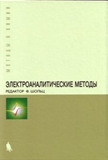
(With contributions by A. M. Bond, R. G. Compton, D. Fiedler, G. Inzelt, H. Kahlert, S. Komorsky-Lovric, K.-H. Lohse, M. Lovric, F. Marken, A. Neudeck, U. Retter, F. Scholz, Z. Stojek), Russian edition of “Electroanalytical Methods – Guide to Experiments and Applications” (Springer 2002, ISBN 3-540-42229-3)
Encyclopedia of Electrochemistry, Edited by A.J. Bard and M. Stratmann Volume 7a: Inorganic Chemistry
Encyclopedia of Electrochemistry, Edited by A.J. Bard and M. Stratmann Volume 7b: Inorganic Chemistry
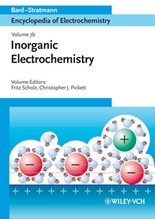
Volume edited by F. Scholz and C. J. Pickett, WILEY-VCH, 2006, ISBN-13: 978-3-527-31700-1, ISBN-10: 3-527-31700-5, 527 p.
Book Chapters
Common types of salt bridges and diaphragms
F. Scholz
in: Handbook of Reference Electrodes (Eds. A. Lewenstam, G. Inzelt, F. Scholz)
Springer, 2013, p. 49-56
Electrochemistry of Adhesion and Spreading of Lipid Vesicles on Electrodes
V. A. Hernández, U. Lendeckel, F. Scholz
in: Modern Aspects of Electrochemistry (Eds. C. G. Vayenas, R. E. White), Vol.: Applications of Electrochemistry in Medicine (Ed. M. Schlesinger)
Springer, 2013, p. 189-247
(a) Thermodynamics of electrochemical reactions, F. Scholz, Chapter I.2
(b) Electrochemical studies of solid compounds and materials, D. A. Fiedler, F. Scholz, Chapter II.8
(c) Seminal Publications in electrochemistry and electroanalysis, F. Scholz, G. Inzelt, Z. Stojek, Chapter IV.1
(d) Textbooks on Fundamental Electrochemistry and Electroanalytical Techniques, F. Scholz, Chapter IV.2
in: Electroanalytical Methods – Guide to Experiments and Applications
(Ed. F. Scholz), Springer, 2002,
Springer, 2005, 2nd corrected printing
Springer, 2010, 2nd revised and extended edition
Solid State Electrochemical Reactions of Electroactive Micro- and Nano-Particles in a Liquid Electrolyte Environment
M. Hermes, F. Scholz
in: Handbook of Solid State Electrochemistry. (Ed. V. Kharton). Wiley-VCH, Weinheim, 2009
Electrochemistry of Polycyanometalates
F. Scholz, H. Kahlert
in: Encyclopedia of Electrochemistry (A.J. Bard, M. Stratmann, Eds.)
Volume 7b: Inorganic Chemistry (Eds. F. Scholz and C. J. Pickett), Chapter 23, WILEY-VCH, Weinheim 2006, p. 701-721
Voltammetry of Solid Microparticles Immobilized on Electrode Surfaces
F. Scholz, B. Meyer
in: Electroanalytical Chemistry, A Series of Advances (Eds. A. J. Bard, I. Rubinstein)
Vol. 20, 1998, pp.1, Marcel Dekker, Inc.
Silver: (b) compound determination
F. Scholz, B. Lange
in: Encyclopedia of Analytical Science (Eds. A. Townshend, P. J. Worsfold, S. J. Haswell, R. Macrae, H. W. Werner, I. D. Wilson)
Academic Press, Oxford 1995, Vol. 8, p. 4676-4679

